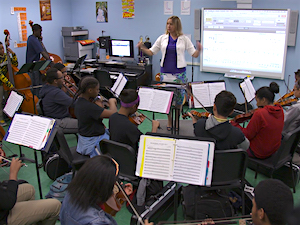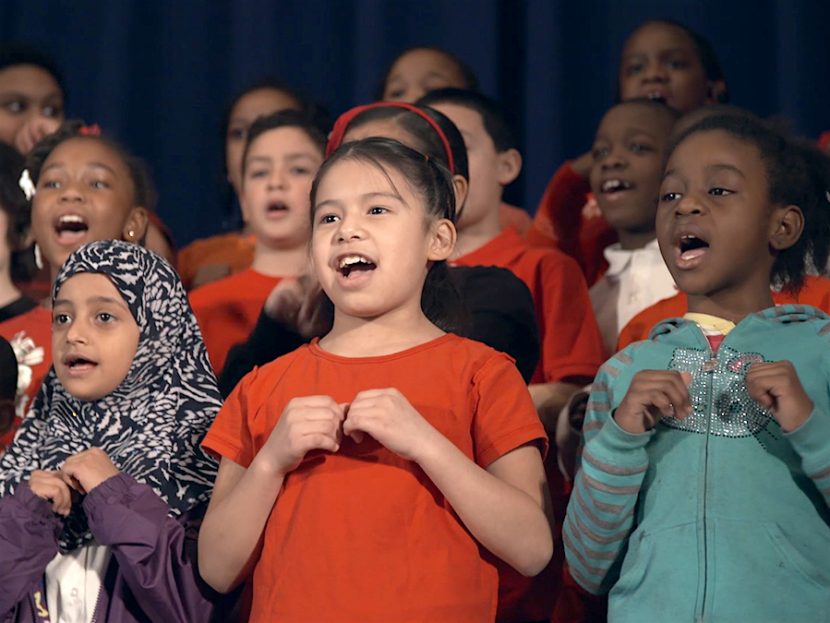Teaching music in inner-city schools can have positive and long-lasting benefits for students from low-income communities. Enhanced academic performance and social/emotional development demonstrate how exposure to the arts can help students succeed in school as well as in life.
by Nitasha Maindiratta
Kevin Heathwood and Mary Landry work with economically-disadvantaged students through New York City’s Education Through Music (ETM). ETM trains teachers to work in inner-city schools and then hires them to teach music as a core subject at ETM partner schools.
Heathwood, who is teaching music at M.S. 180 in the Bronx, attended Indiana University Jacobs School of Music with a major in Music Education and received his Masters in Music Education from Columbia University. Landry teaches at P.S. 68 in the Bronx, and attended the Hartt School of Music at the University of Hartford for her undergraduate degree and received her graduate degree at the Crane School of Music at SUNY Potsdam.
Heathwood and Landry share their experience and advice for those who are considering making a difference teaching music education in inner-city schools.
What are some of the challenges of teaching music in an inner-city school?
Kevin Heathwood: Sometimes, there is not much support from home when teaching students from low-income communities. There is no one right answer on how to help such students, so you have to really get to know each student and figure out what is best to help them succeed. It can be time consuming, but it really makes the educational experience more enjoyable for both the student and teacher.
Mary Landry: Classroom management is a little trickier than it might be in a suburban or rural school. Some of our students come from home lives that aren’t ideal. You really have to manage the class through intrinsic motivation and teach them to care about their journey and their musical product at the end of it as much as you do.
What are some of the joys?
KH: No matter the socioeconomic status, students are influenced by their educators. Students from inner-city schools, however, may have few other influences in their lives and some really depend on great educators impacting their lives in positive ways.
With less economically-advantaged students, it is easier to see how much they rely on my teachings to help them get through whatever it is they are going through. The joy comes from seeing them grow up and become successful members of society and knowing, even if it was a small part, that you had something to do with helping them get there.
ML: I’ve worked in a very affluent community where the students practiced for hours each week. Many of my students here practice that much as well but for different reasons. Music is an escape from reality for some of them. It offers a sense of joy and self-fulfillment they would never have had the opportunity to experience otherwise.
How did you prepare for working with your students? What support and training did you find most useful?
KH: I taught in a wide variety of situations. The drastic differences among these positions gave me venues to grow as an educator.
Upon getting my job with ETM, I didn’t have any experience teaching students from inner-city schools, but I had multiple experiences where I needed to be able to creatively problem solve and adapt to my new environment. The ETM support system was a great help because at the end of the day, I knew I wasn’t alone.
Having multiple professional development sessions through ETM was very helpful, and showed me and other teachers how to talk with the families, and how to find a solution and ensure that every child who is interested gets the instrument they deserve.
 Because of the strong professional development network ETM provides its teachers, seeing seasoned teachers in action and seeing how they talk and interact with families was invaluable. It really made me feel comfortable as a new teacher to this environment.
Because of the strong professional development network ETM provides its teachers, seeing seasoned teachers in action and seeing how they talk and interact with families was invaluable. It really made me feel comfortable as a new teacher to this environment.
ML: ETM immerses itself in the school culture and provides professional development to ensure that the teachers maintain their passion and continual self-improvement.
There were a few professional development sessions where people were brought into the ETM office to address the teachers about working with students from inner-city schools. A former Bronx principal and superintendent made a few points in his presentation that were very helpful about how to relate to the students, what is expected and how to keep a clear perspective.
What are some of the things you’ve learned while teaching music to students from low-income communities?
KH: The biggest thing I’ve learned is that every kid can learn. It is just about finding the right process to make that happen. At times, I’ve learned to use music as a tool to teach more life and social skills.
ML: I’ve learned that students from low-income communities are children just like any other children. You’ll have students whose lives are touched by music and some students whose lives aren’t, just like at any other school. Sure, the motives behind some of their behaviors are different, but once you figure that out, it’s not so different from a school outside of the city.
Any favorite stories to share?
KH: My students and I stepped up to the stage at the ETM Festival and hit the first note of our second selection, Star Wars Saga by John Williams, a high school level piece. Immediately the crowd’s reaction was shock and awe. At the beginning of the first theme, the crowd erupted in applause. I couldn’t help but smile, thinking in my head, “Oh yeah, we did it,” and I looked at all of the students’ faces as they were playing with the same look in their eyes. It made me full of pride for each of them because they are all such great kids and worked so hard. I have no doubt they will take the lessons, not just musical lessons, but everything I taught them – and use them on their journey to success wherever life takes them.
ML: There is always a moment that comes every year in 5th grade orchestra when I’m tuning instruments and the students are practicing individually at their seats, when suddenly I hear two students start to play the same passage together. Then another will join. Then another. Then maybe some students from another section will join. Then the whole orchestra will start playing at the same point in the music together. Then a student will make an observation about how to make the music better and they’ll go back and play that part again. Pretty soon fifteen minutes of rehearsal have passed and the students still haven’t realized I’m sitting in the auditorium seats, watching them rehearse themselves. That’s always a proud moment for me. After all, isn’t that our goal as music teachers, to help students become independent music lovers and learners?
Advice for those looking to work as a music teacher in an inner-city school?
KH: Your first year is going to be tough. You will make mistakes. But then you will see a growth in your students and yourself. You may have felt a lesson was a disaster, but then students come up to you and say “thank you,” and you realize that all this stress and work is worth it. It means something. Believe in yourself, believe in the system, and make a difference.
ML: Focus on the good. There are students whose lives you will transform through the power of music, just as we always dreamed we would when we were in college. Concentrate on the hundreds of students who will have a positive musical experience because you were their teacher.
Nitasha Maindiratta works with the Education Through Music (ETM) team. ETM partners with inner-city schools to provide music as a core subject for all children, and utilizes music education as a catalyst to improve academic achievement, motivation for school and self-confidence. Currently, the nonprofit serves nearly 27,000 students in 48 inner-city schools.




Leave a Reply